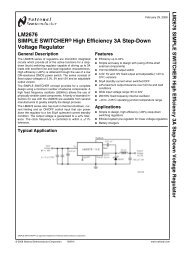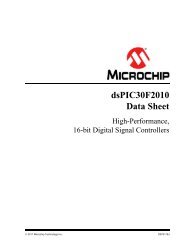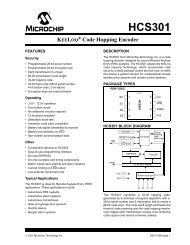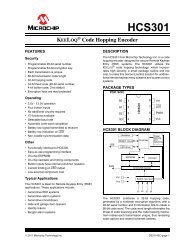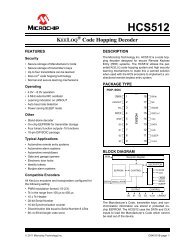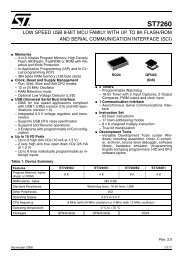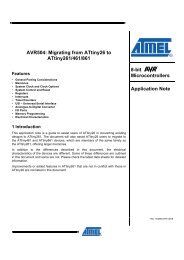Create successful ePaper yourself
Turn your PDF publications into a flip-book with our unique Google optimized e-Paper software.
<strong>STM32W108C8</strong><br />
Serial interfaces<br />
Table 39.<br />
SC1 GPIO usage and configuration<br />
Interface PB1 PB2 PB3 PB4<br />
SPI - Master<br />
SC1MOSI alternate<br />
output (push-pull)<br />
SC1MISO input<br />
SC1SCLK alternate<br />
output (push-pull);<br />
special SCLK mode<br />
(not used)<br />
SPI - Slave<br />
SC1MISO alternate<br />
output (push-pull)<br />
SC1MOSI input SC1SCLK input SC1nSSEL input<br />
I 2 C - Master<br />
SC1SDA alternate<br />
output (open-drain)<br />
SC1SCL alternate<br />
output (open-drain)<br />
(not used)<br />
(not used)<br />
UART<br />
TXD alternate<br />
output (push-pull)<br />
RXD input nCTS input (1)<br />
nRTS alternate<br />
output (push-pull)<br />
(1)<br />
1. used if RTS/CTS hardware flow control is enabled.<br />
Table 40.<br />
SC2 GPIO usage and configuration<br />
Interface PA0 PA1 PA2 PA3<br />
SPI - Master<br />
SC2MOSI<br />
Alternate Output<br />
(push-pull)<br />
SC2MISO Input<br />
SC2SCLK<br />
Alternate Output<br />
(push-pull), special<br />
SCLK mode<br />
(not used)<br />
SPI - Slave<br />
I 2 C - Master<br />
SC2MOSI<br />
Alternate Output<br />
(push-pull)<br />
(not used)<br />
SC2MISO Input SC2SCLK Input SC2nSSEL Input<br />
SC2SDA Alternate<br />
Output (open-drain)<br />
SC2SCL Alternate<br />
Output (open-drain)<br />
(not used)<br />
9.3 SPI master mode<br />
The SPI master controller has the following features:<br />
●<br />
●<br />
●<br />
●<br />
●<br />
Full duplex operation<br />
Programmable clock frequency (6 MHz max.)<br />
Programmable clock polarity and phase<br />
Selectable data shift direction (either LSB or MSB first)<br />
Receive and transmit FIFOs<br />
● Receive and transmit DMA channels<br />
The SPI master controller uses the three signals:<br />
● MOSI (Master Out, Slave In) - outputs serial data from the master<br />
● MISO (Master In, Slave Out) - inputs serial data from a slave<br />
● SCLK (Serial Clock) - outputs the serial clock used by MOSI and MISO<br />
The GPIO pins used for these signals are shown in Table 41. Additional outputs may be<br />
needed to drive the nSSEL signals on slave devices.<br />
Doc ID 018587 Rev 2 74/215





